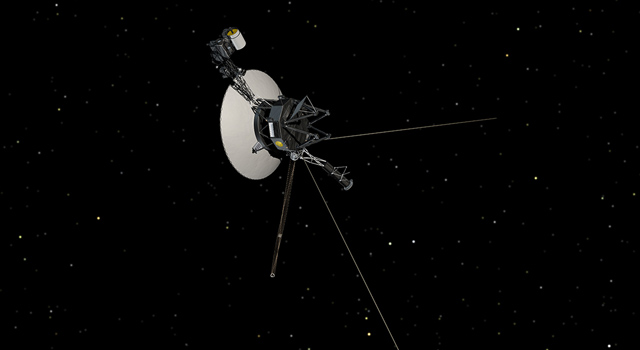News | June 10, 1997
Legacy of JPL's Voyager Missions Highlighted in Evening Talk

"A Celebration of JPL: the 20th Anniversary of the Voyager Launches" will be the theme for a free public presentation to be held at 7 p.m., Thursday, June 19, in JPL's von Karman Auditorium, 4800 Oak Grove Drive, Pasadena. Seating is on a first-come, first-served basis.
The twin Voyager 1 and Voyager 2 spacecraft were launched in fall 1977 for a tour that would explore for the first time all of the giant outer planets, their ring systems,and 48 of their moons. Taking advantage of a rare geometric arrangement of the outer planets in the late 1970s and into the 1980s, the Voyagers were able to conduct a four-planet tour using a minimum of propellant and trip time. This layout of Jupiter, Saturn, Uranus and Neptune, which occurs about every 175 years, allowed the Voyagers to swing from one planet to the next without the need for large onboard propulsion systems.
During the 1979 encounter with Jupiter, Voyager 1 revealed a faint, dusty ring around the giant planet, while the Great Red Spot was imaged in detail as a complex storm moving in a counterclockwise direction. The moon Io excited scientists and the world with the first ever evidence of active volcanism on another body in the solar system. Ganymede revealed cratered and grooved terrain that suggested to scientists Ganymede's entire icy crust had been under tension from global tectonic processes, and Callisto showed the Voyagers an ancient, heavily cratered crust showing faint rings left by enormous impact craters. Three satellites, Adrastea, Metis and Thebe, were also discovered.
During the 1980 and 1981 encounters with Saturn, the Voyagers imaged unexpected structures such as kinks and spokes in Saturn's ring system. At Uranus in 1986, Voyager 2 found a magnetic field tilted 60 degrees from the planet's axis of rotation that twisted into a long corkscrew shape behind the planet. Voyager 2 also found 10 new moons around Uranus, bringing the total number to 15.
Long, bright clouds, similar to cirrus clouds on Earth, were seen high in Neptune's atmosphere during Voyager 2's 1989 encounter. The strongest winds on any planet were measured on Neptune. Triton, Neptune's largest moon, showed active geyser- like eruptions spewing invisible nitrogen gas and dark dust particles several kilometers into the planet's atmosphere.
Voyager 1 is now leaving the solar system, rising above the ecliptic plane, while Voyager 2 is heading out of the solar system below the ecliptic plane. Now called the Voyager Interstellar Mission, the spacecraft are returning data to characterize the outer solar system environment and search for the heliopause boundary, the outer limit of the Sun's magnetic field and outward flow of the solar wind. Each Voyager spacecraft has seven science instruments returning data, and flight controllers believe both spacecraft will continue to operate and send back valuable data until at least the second decade of the 21st century.
Presenting the evening talk will be JPL Director Dr. Edward Stone, who is also the Voyager Project Scientist. He became the Voyager Project Scientist in 1972, and has served as Director of JPL since 1991. Stone has been a principal investigator on nine NASA spacecraft missions and a co-investigator on five other NASA missions, and has received two NASA Outstanding Leadership Medals in addition to several more from both NASA and other astronautical organizations. He is a fellow in the American Astronautical Society, and holds both a master's degree and Ph.D in physics from the University of Chicago.
This lecture is part of the von Karman Lecture Series held monthly by the JPL Public Information Office. A web site on the lecture series is located at http://www.jpl.nasa.gov/lecture. For directions and other information, call the Public Information Office at (818) 354-5011.
